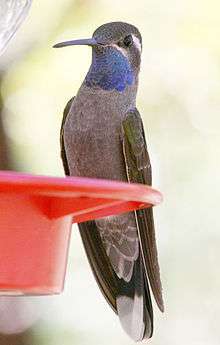Blue-throated mountaingem
| Blue-throated mountaingem | |
|---|---|
 | |
| Male | |
| Scientific classification | |
| Kingdom: | Animalia |
| Phylum: | Chordata |
| Class: | Aves |
| Order: | Apodiformes |
| Family: | Trochilidae |
| Genus: | Lampornis |
| Species: | L. clemenciae |
| Binomial name | |
| Lampornis clemenciae (Lesson, 1829) | |
The blue-throated mountaingem, also known as the blue-throated mountain-gem or blue-throated hummingbird (Lampornis clemenciae) is a species of hummingbird, a member of the family Trochilidae of birds.
Description
The Blue-throated mountaingem is a fairly large hummingbird, reaching 11.5 to 12.5 cm (4.5 to 4.9 in) in length and 6 to 10 grams in weight. The Blue-throated Hummingbird is dull green on the top of its body, fading to medium gray on its belly. It has a conspicuous white stripe behind its eye and a narrower stripe extending backward from the corner of its bill, bordering a blackish cheek patch. Its tail feathers are iridescent blue-black with broad white tips on the outer two to three pairs. The species gets its name from the adult male's iridescent blue throat patch (gorget), but the female lacks this, having a plain gray throat.
Behavior
The blue-throated mountaingem is native to mountain woodlands of Mexico, although during the summer it is an uncommon to rare resident of moist, wooded canyons in the Madrean sky islands of southeastern Arizona, southern New Mexico, and western Texas in the United States and northeastern Sonora, Mexico. A few individuals traditionally winter at feeding stations in southeastern Arizona.
Song
Males sing two types of songs: a simple "peep song," which sounds like a squeaky wheel lasting about 1 second, and a quiet but complex "whisper song" lasting as long as 8 seconds.[2] The female is also reported to sing during the breeding season to attract the attention of males.[2] A male song differs in several respects from other oscine birds in that it uses sharp atonal forceful trills and clicks, and has an unusually large vocal range of 1.8 to 30 kHz.[2][3]
The bird also uses ultrasonic vibrations which are not for communication, but possibly serve to flush out and disorient its insect prey.[3]
Nesting
The male takes no part in nest building or care of the young. The female constructs her nest from soft plant fibers, held together and attached to its support (a tree branch, flowering plant, fern, vine, rock shelf, or man-made object such as a wire or nail) using strands of spider silk stolen from spider webs. The exterior is camouflaged with green mosses where available; in drier habitats, moss-like dendroid lichens may be used, or the exterior may be left bare. Blue-throated Hummingbirds frequently nest over water, especially flowing streams. The two white eggs hatch in 17 to 19 days, and the young leave the nest at 24 to 26 days of age. Up to three broods per year are possible under ideal conditions; the female usually builds each new nest atop the previous nest, leading to nest "towers" at traditional nest sites.
Diet
Like other hummingbirds, the blue-throated mountaingem feeds on nectar from flowers and catches insects in flight and by gleaning from vegetation. In winter, sap from wells drilled by sapsuckers may substitute for nectar.
See also
- Williamson, S. L. 2000. Blue-throated Hummingbird (Lampornis clemenciae). In The Birds of North America. No. 5231 (A. Poole and F. Gill, eds.). The Birds of North America, Inc., Philadelphia, PA.
- Williamson, S. L. 2001. A Field Guide to Hummingbirds of North America (Peterson Field Guide Series). Houghton Mifflin. Co., Boston, MA.
References
- ↑ BirdLife International (2012). "Lampornis clemenciae". IUCN Red List of Threatened Species. Version 2013.2. International Union for Conservation of Nature. Retrieved 26 November 2013.
- 1 2 3 Ficken FS, Rusch KM, Taylor SJ, Powers DR (2000). "Blue-Throated Hummingbird Song: A Pinnacle of Nonoscine Vocalizations". Digital Commons, George Fox University.
- 1 2 Pytte CL, Ficken FS, Moiseff A (2004). "Ultrasonic singing by the blue-throated hummingbird: a comparisonbetween production and perception". J Comp Physiol A. 190: 665–73. PMID 15164219. doi:10.1007/s00359-004-0525-4.
External links
- Blue-throated Hummingbird photo, Article Southeast AZ: Arizona-Sonora Desert Museum
- Blue-throated Hummingbird photo; photo-2 focusonnature.com
- Blue-throated Hummingbird photo gallery with picture of nest, & egg clutch
